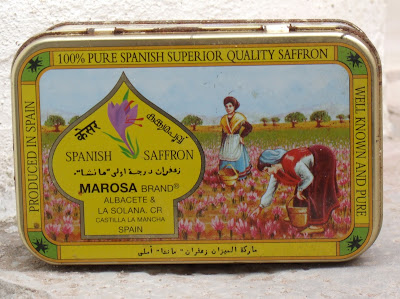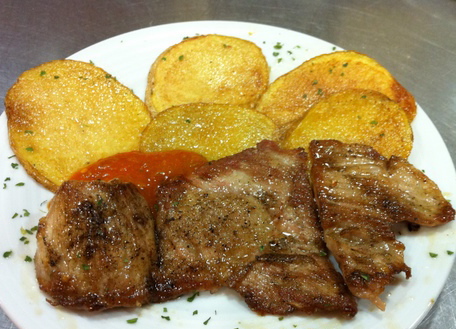I´m just mad about saffron
 |
| Worth its weight in gold |
Spanish food lovers argue that their azafran (saffron from the plains
of Castilla-La-Mancha) is unrivalled across the world. They have even
nicknamed it ‘oro’, gold.I would tend to agree.
Saffron was introduced to Spain by the Moors in the tenth century. (Its name derives from an Arabic word of unknown origin, za'faran.)and Spain is now the second largest saffron producer in the world, after Iran.
For two to three weeks each October, Spanish growers and their families will be pushed busywise.The reason being - the saffron harvest.With the searing summer heat now passed, villagers will flock to nearby fields and begin the arduous task of plucking purple crocus heads.The source of this complexity is the crocus flower´s style,which carries
tiny trumpet-like,orange-red stigmas.The flowers grow close to the
ground, must be hand picked and the yellow staining stigmas then
carefully removed and dried.
These blooms containing these strikingly coloured stigmas are, when dried, the much sought after saffron – the world’s most expensive spice.
There is no machine that can strip the saffron flowers, just as there
is no mechanical way to speed up their harvest. Hardworking hands must
process about 250,000 flowers to produce just one kilo of dry saffron.
Hence the spice's astronomical price. Only after having gathered about 14,000 stigmas will there be enough to make just 28g of the spice. Like freshly roasted coffee beans and vanilla pods,saffron has one of those almost indescribable yet addictive aromas.Descriptions include honeyed,floral,spicy,pungent,bitter,woody and earthy.Saffron´s affinity with foods common to the countries of its cultivation has continued through the centuries.During the Middle Ages, the use of saffron in cooking spread throughout Europe. Today it still perfumes rice in Persian polos, it is the defining ingredient in Kashmiri biryanis, Italy´s risotto alla milanese, Spain´s paella, the bouillabaisse of Provence and Portugal´s caldeirada de peixe and is essential to the cuisines of India, Morocco, and Iran. It has
also been coveted throughout history as a dye, a perfume, and a
medicine. Alongside Don Quixote, Manchego cheese and the Man of la Mancha, the hit of the 1965 Broadway season, the show that introduced "The Impossible Dream" to the world (and lounge singers everywhere!!!), Castilla-La-Mancha can
rightfully hail its saffron to be one of its most famous exports.
Saffron, the lady of La Mancha and most exotic of spices, is a
perfect partner for infusing with alcohol.Only a pinch of saffron is
needed for most dishes.A large pinch equals about one teaspoon (100mg)
and a small pinch,1/4 to1/2 teaspoon (25-50mg).Amounts can be adjusted
according to taste,however too much will make a dish taste bitter and
medicinal.Before being added to a dish saffron threads should be crushed
to a powder with the back of a spoon and then infused in a hot fat-free
liquid such as water, white wine or citrus juices.Try one of two versions of the Alchemists pudding, my tart based recipe and Adrian Henry´s inspired take on this same dessert in his new book Cuoco.


Comments
Post a Comment